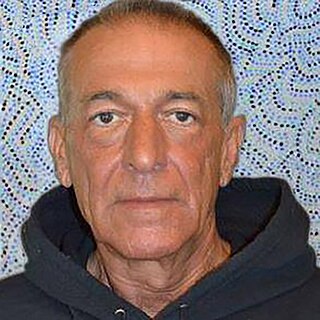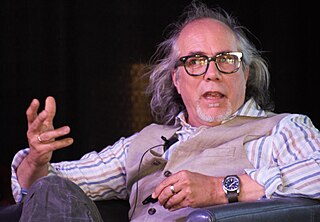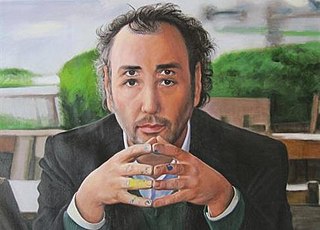Related Research Articles

Mendi Obadike and Keith Obadike are a Black American couple who are artists and educators, of Igbo Nigerian heritage. They create music, writing, and art. Their music, performance art, and conceptual internet artwork have been exhibited internationally. They are both professors at Cornell University.

Lawrence Charles Weiner was an American conceptual artist. He was one of the central figures in the formation of conceptual art in the 1960s. His work often took the form of typographic texts, a form of word art.
G. H. Hovagimyan is an American experimental cross-media, new media art and performance artist who lives and works in New York City.

Stephanie Syjuco, is a Filipino-born American conceptual artist and educator. She works in photography, sculpture, and installation art. Born in the Philippines, she moved to the San Francisco Bay Area in 1977. She lives in Oakland, California, and teaches art at the University of California, Berkeley.
Marisa Olson is an artist, writer, curator, and former punk singer. In 2004 she auditioned for popular American television show American Idol as an artistic project. Over the course of three months of daily "training exercises," it is revealed that she is critiquing gender norms entrenched by the show, while also using the popularity of her site to speak to readers about using their voice to vote in elections as well as on the show.
Rhizome is an American not-for-profit arts organization that supports and provides a platform for new media art.

Charissa Jean Thompson is an American television host and sportscaster working for Fox Sports and Amazon Prime Video. Previously, Thompson worked for ESPN, Versus, as well as for GSN and the Big Ten Network. She was the co-host of SportsNation along with Marcellus Wiley until her departure from ESPN for Fox Sports in June 2013. She became the host of Fox Sports Live on the new Fox Sports 1 network when it debuted on August 17, 2013. She also was one of the American hosts of Ultimate Beastmaster. From 2014 to 2017, Thompson was a co-host on the syndicated entertainment news show Extra.
Ryan Humphrey is an American artist who currently lives and works in New York City. His work has been featured in the traveling exhibition Will Boys Be Boys? curated by Shamim Momim of the Whitney Museum of American Art. Humphrey's most recent solo exhibition, All of Nothing, was at DCKT Contemporary. Humphrey was also a contestant in Season I of Top Design, Bravo's reality show.

Tullio Francesco DeSantis, also known as Tullio, is an American contemporary artist, writer, technologist, and teacher. His work is informed by ancient and contemporary philosophy, science, and the relationship between art and life.
Jill Magid is an American conceptual artist, writer, and filmmaker. Magid’s performance-based practice "interrogates structures of power on an intimate level, exploring the emotional, philosophical, and legal tensions that exist between institutions and individual agency.”

Internet art is a form of new media art distributed via the Internet. This form of art circumvents the traditional dominance of the physical gallery and museum system. In many cases, the viewer is drawn into some kind of interaction with the work of art. Artists working in this manner are sometimes referred to as net artists.

Iñigo Manglano-Ovalle is an American conceptual artist known for multidisciplinary, socially oriented sculpture, video and installations and urban community-based projects of the 1990s. His work often explores a dialectical relationships involving minimalist aesthetics, the utopian ambitions of modernism and science, and the resulting—often negative—social, geopolitical and ecological consequences of such ideologies. New York Times critic Holland Cotter wrote that Manglano-Ovalle was adept in "distilling complex ideas into inviting visual metaphors," while Jody Zellen described his work as "infused with a formal elegance and sociopolitical content." Manglano-Ovalle has been featured in solo exhibitions at the Art Institute of Chicago, MASS MoCA, Museo Tamayo Arte Contemporaneo and Museum of Contemporary Art, Chicago (MCA), and participated in Documenta 12, the Venice Biennale, Whitney Biennial, and Bienal de São Paulo. He has been recognized with MacArthur Foundation, Guggenheim, and National Endowment for the Arts fellowships and his work belongs to the collections of forty major institutions. He has been a professor at Northwestern University since 2012 and lives and works in Chicago.

Petra Cortright is an American artist working in video, painting, and digital media.

Genco Gülan is a contemporary conceptual artist and theorist, who lives and works in Istanbul. His transmedia contextual work involves painting, found objects, new media, drawings, sculpture, photography, performance and video.

Yale Union was a nonprofit contemporary art center in southeast Portland, Oregon, United States. Located in the Yale Union Laundry Building built in 1908, the center was founded in 2008. In 2020, the organization announced it would transfer the rights of its building to the Native Arts and Cultures Foundation (NACF). It dissolved the nonprofit after wrapping up its program in 2021 and completing the building and land transfer. The space is now the Center for Native Arts and Cultures.
Ryder Ripps is an American conceptual artist, programmer, and creative director.

Morehshin Allahyari is an Iranian media artist, activist, and writer based in New York. Her work questions current political, socio-cultural, and gender norms, particularly exploring the relationship between technology, history, and art activism. Allahyari’s artworks include 3D-printed objects, videos, experimental animation, web art, and publications. As a 2017 Research Resident at Eyebeam, Allahyari also worked on the concept of "Digital Colonialism"; a term she has coined since 2015.

Nadia Kaabi-Linke is a Tunis-born, Berlin-based visual artist best known for her conceptual art and 2011 sculpture Flying Carpets. Her work has explored themes of geopolitics, immigration, and transnational identities. Raised between Tunis, Kyiv, Dubai and Paris, she studied at the Tunis Institute of Fine Arts and received a Ph.D. in philosophy of art from the Sorbonne. Kaabi-Linke won the 2011 Abraaj Group Art Prize, which commissioned Flying Carpets, a hanging cage-like sculpture that casts geometric shadows onto the floor akin to the carpets of Venetian street vendors. The piece was acquired by the New York Guggenheim in 2016 as part of their Guggenheim UBS MAP Global Art Initiative. Kaabi-Linke also won the Discoveries Prize for emerging art at the 2014 Art Basel Hong Kong. Her works have been collected by the Museum of Modern Art, Dallas Museum of Art, Burger Collection, and Samdani Art Foundation, and exhibited in multiple solo and group shows.
Émilie Gervais is a Canadian new media artist based in Paris, France. Her work explores the relationships between internet, network culture, art and its mediation. In the past, she has described herself as, "a starry background artist working with the internet, deleting and restoring stuff, interacting with stuff and people".

Anna Sokolina, PhD is an American architect, scholar, and curator, Routledge featured author, Founding chair of Women in Architecture Affiliate Group of the Society of Architectural Historians (SAH), Advisory Board member of H-SHERA Network, and Honorary advisor of International Archive of Women in Architecture.
References
- ↑ Brendan Carroll, "Internet Forager Shuns Art World; Embraces Open Source," Art21 Magazine, September 24, 2012
- ↑ Rebecca Dube, "Frenemies Can Be Hard on the Heart," The Globe and Mail, June 27, 2007, updated April 3, 2009
- ↑ Fi Glover, "You Like Bush? You Must Be a Nu-Metal Fan," The Guardian, August 27, 2003
- ↑ Jonah Brucker-Cohen, "Interview With Angie Waller," Rhizome, November 19, 2003
- ↑ Karen Rosenberg, "Art in Review: Custom Car Commandos," The New York Times, February 27, 2009
- ↑ Charissa N. Terranova, Prosthetic: Technological Mediation and the Car in Conceptual Art , University of Texas Press, January 16, 2014, pages 214-215. ISBN 9780292754515
- ↑ Carolyn Wong, "After Years of Copyright Law Reviewing Art, an Artist Reviews Copyright Law," Lexology, May 6, 2011
- ↑ Alice Gregory, "Words and Other Crimes," Idiom, September 1, 2010
- ↑ Lori Waxman, "An Alternative Summer Reading List," Chicago Tribune, July 13, 2011
- ↑ Sarah Bodman, "Transforming Artist Books: What Do You Want to Make Today?" Tate, August 22, 2013
- ↑ "Squareeater and Unknown Unknowns Recap," Pretty Conceptual, December 4, 2012
- ↑ Ceci Moss, rhizome.com, October 28, 2010